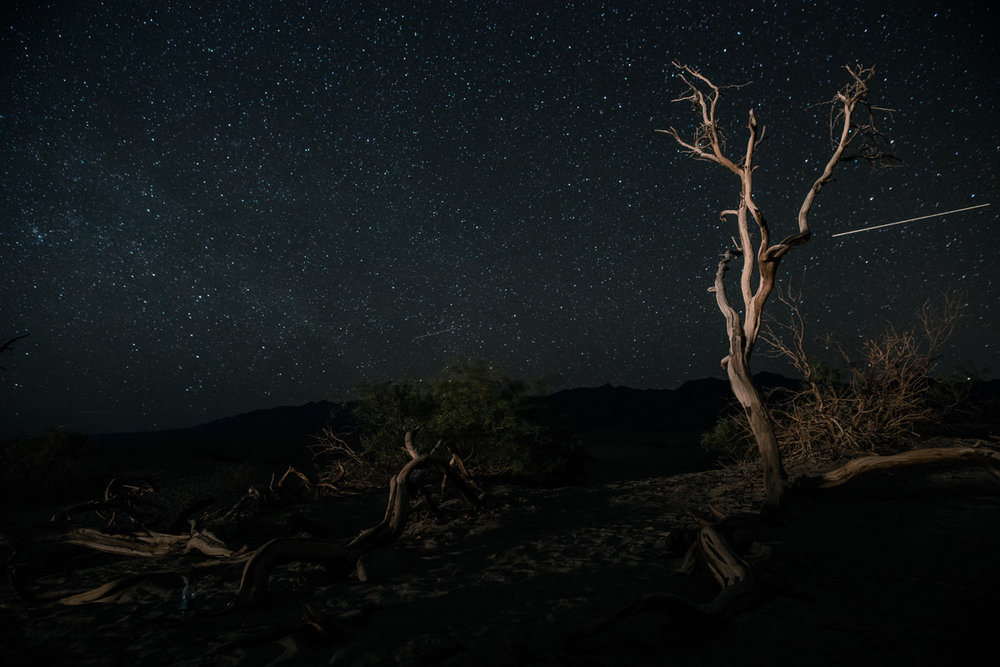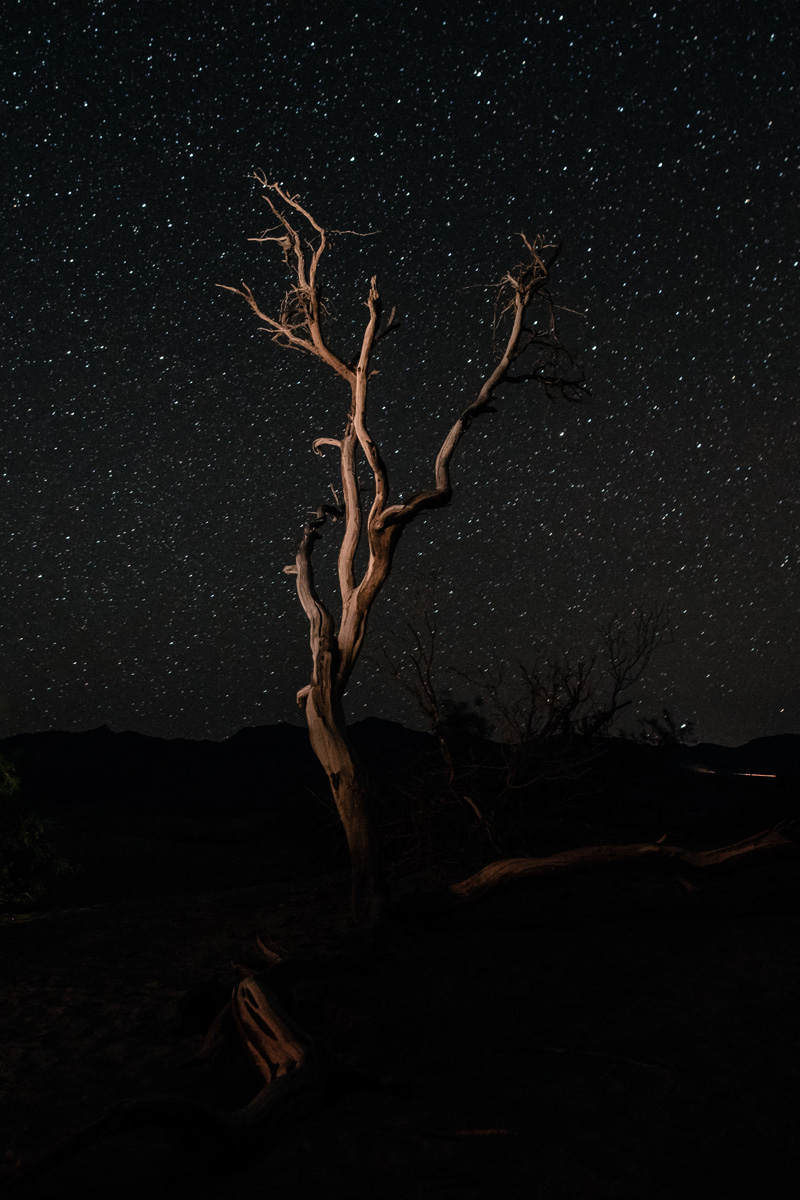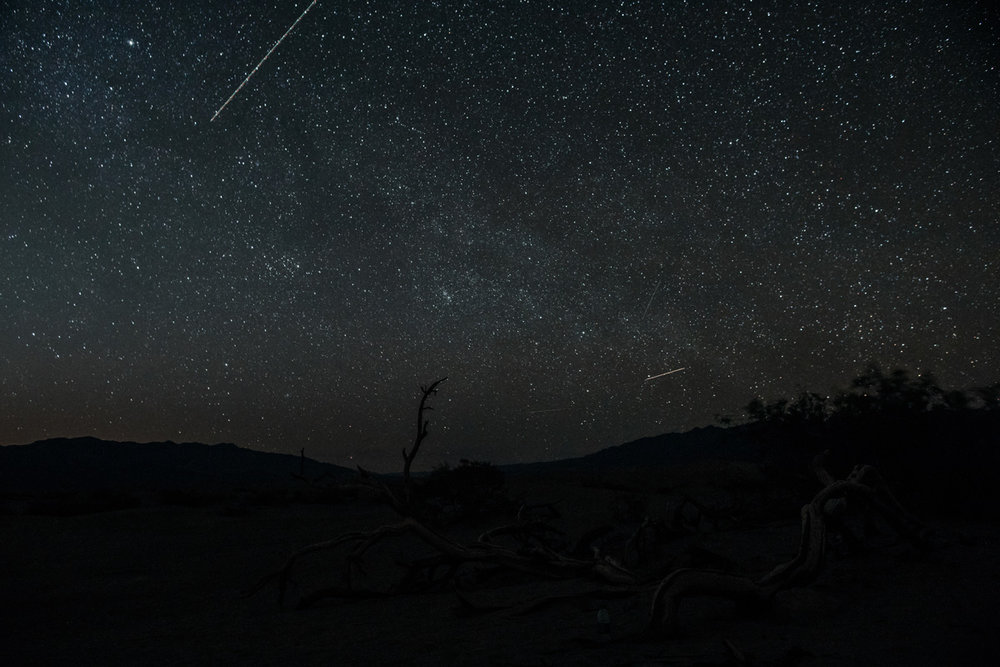
Astrophotography is the art of capturing photographs of the night sky. Most commonly utilizing long exposure techniques, photographers can create multitude of unique and powerful images that can illuminate dark landscapes and bring clarity to the stars and planets in the solar system. For many still, having the opportunity to capture photos of the Milky Way Galaxy at certain times also makes for stunning imagery.
While all of photography has some subjective component (you know…the art…), astrophotographers, in general, follow similar rules of approach. This is due to the technologies at play. The camera body you shoot with will help to dictate some of your options, with higher end camera models (such as the Canon 5D Mark III and Mark IV that we use) enabling indefinite exposure times (through using Bulb mode) and syncing with external remotes (or your phone) in order to control the shutter without pressing the shutter button on the camera itself (to help avoid shake). These are just a few little items – and when it comes to lenses, they matter too!
For the sake of this article, let’s make a general assumption: astrophotographers are typically looking to capture photos of the night sky, stars and all, and framing this in the context of things on ground level. These can be natural features like mountains or trees, or can even be man-made objects like cars. The key component is that you are often looking to capture a lot of information in the frame, not just small abstracted snippets.
introduction
Our intrigue regarding astrophotography was kicked off by watching some YouTube videos that showcase the creative potential, and frankly the impact learning how to do it correctly would have on our general photography understanding. Not to mention, we have an inherent love for space and landscapes. While we most normally do weddings and portrait photography for our “business,” astrophotography and landscape photography are ripe photographic art forms we are able to explore without ever having to consider someone else’s opinion.
Unfortunately, our location in the world isn’t exactly prime territory for doing astrophotography well. Even with the best exposure, our general area has minimal star coverage due to light pollution. While it’s never killed enjoyment of a night sky for us, you never really notice until you have been to a place that has little to no light pollution. In some parts of the world, these are “star parks,” basically areas of land reserved for night sky viewing in a continually expanding world of artificial light. While we have studied how to take pictures of the stars, and have tried practicing in our own backyard, never were we met with such ideal conditions as when we visited Death Valley National Park.
Standing out on the sand dunes in the middle of this national park, and seeing the immaculate beauty of the stars above us was shockingly beautiful. We have seen a lot of wonderful things in our travels, such as the many landscapes and auroras in Iceland, but never have we seen star coverage on this level. We could pick out so many constellations, and even saw a large number of shooting stars. Taking astrophotography was an easy task here, even a mile out into the sand dunes. The resulting photos were stellar, and while we certainly have more to learn, it is a captivating area of photography to explore.
As far as lenses go, investment into a faster lens (lower f/stop number) will show a lot of improvement in your images. Having the option to reach for extra stops of light is beneficial. Additionally, a quality camera body will also assist in gaining a better overall image, though perhaps not as notable of a difference as compared to a lens in this instance. The streamlined reason for this is because, with many astrophotography scenes, you will keep your ISO at 100 (or in this proximity), and the longer exposure time will allow you to compensate for the general darkness in the scene. Unlike wedding photography that would require bumping your ISO significantly (even into the thousands), astrophotography is ideal for non-stressful photography techniques.
types of lenses to consider
In general, wider focal length lenses will be more useful for astrophotography purposes – particularly if you are looking to emulate many of the beautiful photos you see online in this niche. While it is possible to imagine someone taking astro photographic images with a longer focal length, this will likely be limited to very specific, and likely abstract, types of photographs. For the purpose of the lenses highlighted here, we are really looking at the norms of astrophotographers. The primary lens types you will find in use:

-
Super wide angle lenses, which generally range from the area of 6mm to 24mm, are really a quintessential astrophotographers tool. These serve the purpose of capturing a maximum amount of a landscape and night sky in a scene. The majority of astrophotography images you see are going to be taken with camera lenses in this range.
-
Fast wide angle lenses, as would be found in most prime lenses, are lenses with lower f-stops. The option allows you to stop down a few extra stops, allowing you to get better looking and less noise infested images in camera. While average aperture ranges for consumer level lenses are around f/2.8 – f/4 for starting points, faster lenses will allow you to stop down as low as f/1.0.
-
Standard wide angle lenses, which we’d say range from 24mm – 35mm, are those lenses that likely have the potential to be multi-use lenses and more commonly equipped in your personal arsenal of lenses already. As wedding and portrait photographers, 24mm has been a common focal length that we use for establishing shots of venues and landscapes, and 35mm tends to be great for portraits when we need more breathing room in the picture. When shooting astrophotography in Death Valley, we specifically used our Canon 24mm exclusively (as at the time we did not have anything wider).
-
Longer focal length lenses, let’s say anything 50mm and greater, have niche uses in astrophotography. A prime 50mm lens definitely has potential in certain environments, especially when the focus isn’t so much to capture “all” of the night sky, but rather an abstract portion in addition to other landscape elements. Anything much longer on focal length will be taking this same concept and probably applying it to abstract scenes that require the ability to zoom in much further, such as capturing a mountain peak from a far distance with stars behind.
specific lenses we recommend for astrophotography
Now that we have the basic lens categories covered for astrophotography setups, let’s discuss some more specific lens options. As a note, we are Canon shooters, and as a result all of our lenses are Canon branded. We will provide some alternative (but technically comparable) options if you happen to be shooting on another brand of camera such as Nikon, Sony, Olympus, etc and are open to Sigma Art lenses (which tend to be great quality, but more budget friendly pricing).
-
Canon EF 24-104mm f/4 II USM Zoom Lens. We are starting our list of recommendations with the most accessible (and affordable) on this list. The Canon EF 24-104mm lens is one you might consider if you are on a budget, or are just wanting to begin to dabble into astrophotography (or other areas of photography in general). While most lenses we use are in the area of $1,000 – $2,000, this lens provides an $800 option that, while limited in stops of light as the lowest f-stop is f/4, it can make up for this by having a wide range of focal lengths to choose from. This enables you to get the optimal composition without having to also purchases many expensive lenses as well. While not an option we are currently using ourselves, it is a respectable and quality piece of glass considering the cost and flexibility it provides.
-
Canon EF 24mm f/1.4 II ISM Wide Angle Lens. This is, without a doubt, one of our favorite lenses in general. The wide focal length suits astrophotography well, and it also can be utilized in a variety of other shooting environments as well. As we have used this lens extensively, the standout features is the crisp clarity of the images, as well as the color depth. Without speaking from a technical standpoint, we often find ourselves comparing shots with this 24mm to other focal length shots taken of comparable scenes, and on this front the 24mm almost always wins out. The ability to stop down to f/1.4 is also very powerful for many shooting purposes, notwithstanding the benefit given to astro photographers. Highly recommended!!
If you’re interested, you can read our review of the Canon EF 24mm as well.
-
A close comparison is the Sigma 24mm f/1.4 ART DG HSM Lens. Technical specs of this compared to the Canon prime 24mm are quite similar. Each carry equal stops of light and the same focal length. Major differences appear to be in some slow focusing of the Sigma as compared to the Canon lens. This may not be an issue in the context of astrophotography as usually we are not on a time crunch, however for us we prefer the Canon due to it’s performance in multiple photography scenarios (astro photography and otherwise). Still, for about $500 less, this might be something for you to consider.
-
-
Canon 16-35mm f/2.8 III USM Lens. Where the 24mm prime lens discussed above is lacking is it’s flexibility. It serves a very specific purposes (and, again, does it very, very well!), but for some photographers (and budgets), having a lens that can further adapt to different shooting scenarios can be beneficial. While the Canon 16-35mm f/2.8 III USM lens will not give you as many stops of light as a prime lens, shooting night skies at f/2.8 will still be sufficient in most circumstances. The flexibility of the zoom to focal lengths ranging from 16mm to 35mm makes this lens potentially more appealing to landscape artists and astrophotographers in particular. Without the need to swap your lens, you can quickly adjust your composition and take advantage of the really wide angle options at the lower end of the spectrum, a middle of the road wide angle at 24mm, and even compress to 35mm if you need less in the frame or are looking to do some portraiture. As with the 24mm prime, the 16-35mm outputs beautiful quality images. Not to be missed!
-
A close comparison is the Sigma 18-35mm f/1.8 ART DC HSM Lens. The immediate benefit of this lens, aside from the lower price tag, is the additional stops of light when compared with our recommended Canon lens. On the opposite side of things, there is a small loss of 2mm’s (18mm instead of 16mm – not that this will make a big difference to anyone). In reading reviews online, some of the downsides should definitely be considered before purchasing, though, such as: heavy vignetting
on full frame cameras and focusing problems.
-
-
Canon EF 50mm f/1.2 L USM Lens. Our last suggestion of lenses for astrophotography purposes is this special 50mm prime lens. We only recommend this one for astrophotography (and landscape photography) uses if you are already using a wide angle lens. With a tighter focal length, a 50mm lens is said to be the focal length that is most comparable to the human eye and our resulting vision of the world around us. The f/1.2 aperture is one reason in particular why this lens brings something unique to the astrophotography table, as well as the ability to capture photos that are less of a whole scene and more of smaller snippets or abstractions. As with other prime lenses we are using, the quality of the glass, build, and resulting images are all stunning. Well worth every penny, and even more so if you have interest in using it for portrait photography and landscapes during the day.
You can also read our review of the Canon EF 50mm f/1.2 lens!
-
A close comparison option is the Sigma 50mm f/1.4 ART DG HSM Lens. While one stop of light less, this lens is also about 25% cheaper. There are purchasing options to make the lens compatible with your specific camera body brand – Canon option, Sony option, Nikon option, etc.
-

Having the right camera lens is one of the essential starting points to capturing great astro-photographs. While many lenses have their uses, wide angle lenses tend to be preferred among astrophotographers – ourselves included. There is an undeniable thrill of capturing photos of the night sky, the stars, and even our Milky Way Galaxy. We hope you benefit from seeing our list of recommendations for camera lenses suitable for astrophotography here!!